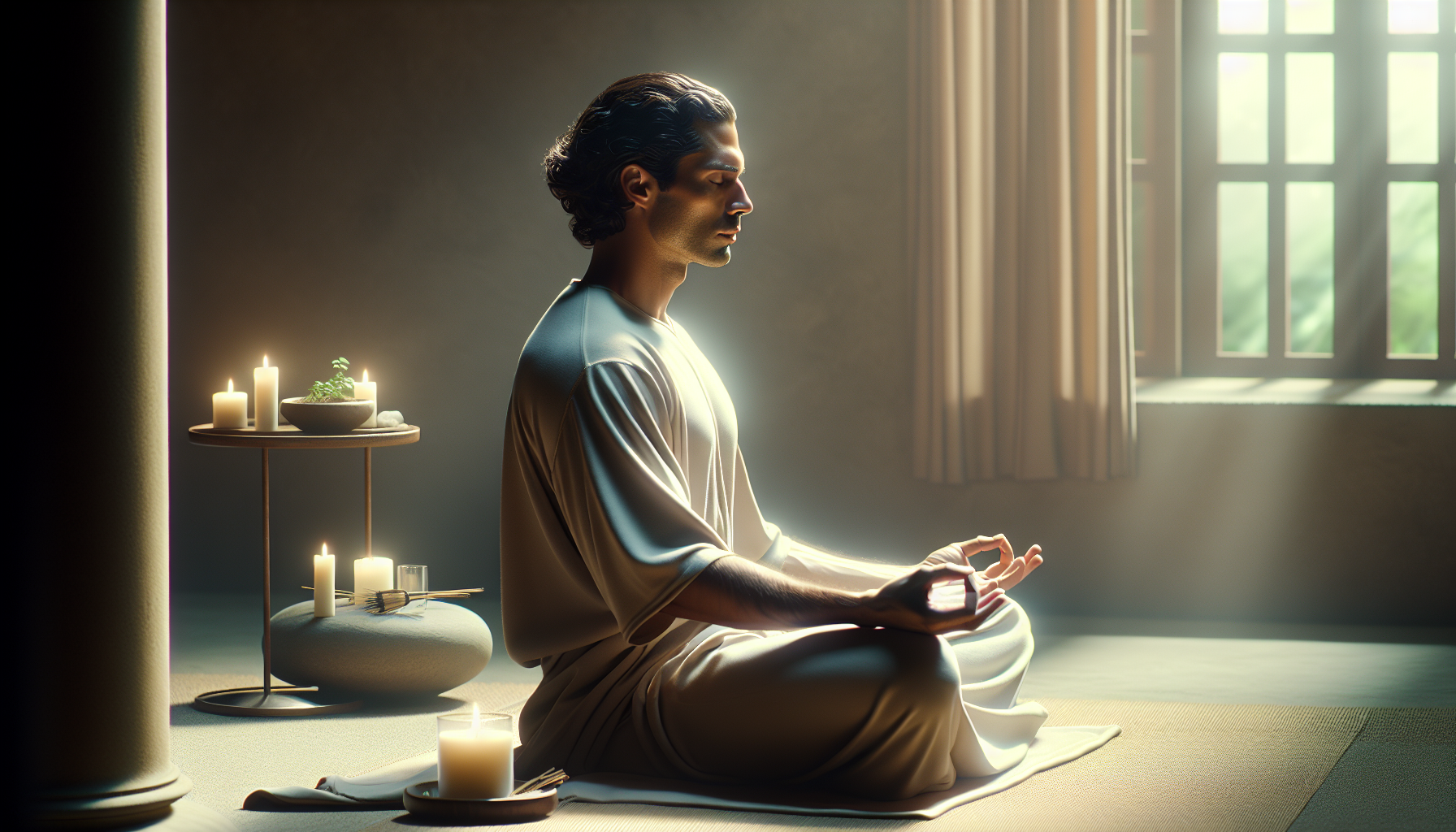In the ever-accelerating whirlwind of modern life, where notifications ping incessantly and multitasking is a badge of honor, the pursuit of mental clarity and focus often feels like chasing a mirage in a desert of distractions. We live in a world where our attention is perpetually divided, our thoughts scattered across the myriad tasks that demand our immediate engagement. It’s no wonder, then, that finding moments of pure focus feels increasingly elusive. But what if the key to unlocking this elusive clarity lies not in doing more, but in intentionally doing less? Welcome to the transformative world of isolation rituals—a practice that is as ancient as it is revolutionary, offering a pathway to reclaiming your mental space and sharpening your focus with laser-like precision. 🔍
Imagine, for a moment, stepping into a cocoon of silence, away from the digital noise and constant demands of daily life. This is not about escapism, but rather a deliberate retreat into solitude with the purpose of rejuvenation and clarity. Isolation rituals are not mere pauses; they are strategic withdrawals designed to recalibrate our mental faculties. In this blog post, we will explore how these rituals can serve as powerful tools to enhance mental clarity and focus, drawing on insights from psychology, neuroscience, and ancient practices. We will delve into the science behind why isolation helps reset our cognitive load, examine various forms of isolation rituals, and provide practical guidance on how you can incorporate these practices into your daily routine.
The science is compelling. Studies have shown that our brains are not built to handle the constant barrage of information that modern life throws at us. When we engage in isolation rituals, we allow our prefrontal cortex—the brain’s command center responsible for decision-making and problem-solving—to rest and rejuvenate. This downtime is crucial for processing information and making connections that are often overlooked in the hustle and bustle. Furthermore, these rituals tap into the brain’s default mode network, a neural network that activates during rest and is vital for self-reflection and creativity. By intentionally isolating ourselves, we create the mental space needed for these critical cognitive processes to flourish.
Isolation rituals come in many forms, each offering unique benefits tailored to individual needs and lifestyles. From silent retreats and digital detoxes to meditative practices and nature walks, the possibilities are as diverse as they are impactful. These rituals are not about rigid schedules or specific locations; they are about creating intentional moments where the mind can wander and wonder, free from external pressures. In the upcoming sections, we will take a closer look at different types of isolation rituals, exploring how they can be customized to fit into your life seamlessly. Whether you have five minutes or five days to spare, there’s a ritual that can help unlock your mind’s potential.
As we journey through this exploration, prepare to uncover not just the methods, but the profound benefits that isolation rituals can bring to your life. Imagine the power of starting your day with a clear mind, ready to tackle challenges with renewed focus and creativity. Picture yourself making decisions with confidence, fueled by the mental clarity that these rituals cultivate. By the end of this article, you will have a roadmap to incorporate isolation rituals into your life, transforming everyday moments into opportunities for growth and introspection. So, take a deep breath, and let’s embark on this transformative journey to unlock the clarity and focus you’ve been seeking. ✨
The Concept of Isolation Rituals
Isolation rituals are powerful practices aimed at enhancing mental clarity and focus by intentionally distancing oneself from distractions and the external world. These rituals are steeped in the idea that isolation, when practiced mindfully, can create a space for introspection and self-discovery. In a world that is constantly buzzing with notifications, social obligations, and endless to-do lists, the art of purposeful solitude has never been more crucial. 🧘♂️
One might question the necessity of such rituals in today’s hyper-connected society. However, numerous studies have shown that periods of isolation can significantly boost creativity, productivity, and overall mental well-being. By creating an environment where one can focus solely on their thoughts and emotions, individuals often find themselves developing a deeper understanding of their motivations, goals, and desires.
To engage in an isolation ritual, it is not mandatory to retreat to a remote cabin in the woods—though some may choose that path. The essence of these rituals can be captured in the comfort of one’s home, a quiet park, or even a cozy corner of a local café. The key is to establish a space free from interruptions, where the mind can wander freely without the pressure of the external world impeding its journey.
Implementing Isolation Rituals: Practical Tips
When considering how to implement isolation rituals, it is essential to understand the practical aspects that can make these experiences fruitful. The following tips serve as a guide for those seeking to unlock their mental clarity and focus through isolation:
- Set a Purpose: Define the objective of your isolation ritual. Whether it’s problem-solving, creative thinking, or emotional processing, having a clear intention can enhance the experience.
- Create a Sacred Space: Designate a specific area where you can retreat. This could be a room, a garden, or any place where you feel comfortable and safe.
- Limit Distractions: Turn off electronic devices, inform others of your need for solitude, and eliminate any potential interruptions.
By incorporating these strategies, individuals can create a conducive environment for self-exploration and growth. An effective isolation ritual is one where the mind is free to wander, reflect, and ultimately, gain clarity.
Benefits of Isolation Rituals
The practice of isolation rituals offers a plethora of benefits, particularly in terms of mental clarity and focus. Here, we delve into some of the most profound advantages that can be realized through these practices:
Enhanced Concentration: In a world filled with distractions, maintaining concentration can be a significant challenge. Isolation rituals create a space where focus can be cultivated, free from the constant pull of external stimuli. This heightened focus allows individuals to engage deeply with their thoughts, leading to more insightful and effective problem-solving.
Emotional Clarity: Isolation rituals provide an opportunity for individuals to process their emotions without external influence. In these moments of solitude, one can confront their feelings, understand underlying causes, and navigate through complex emotional landscapes. This emotional clarity can lead to improved relationships, better decision-making, and increased emotional resilience.
Increased Creativity: Creativity often thrives in solitude. When the mind is free from the constraints of social conventions and expectations, it can explore new ideas and perspectives. Many artists, writers, and innovators have attested to the creative breakthroughs achieved during periods of isolation.
Case Study: Successful Individuals and Isolation Rituals
| Name | Profession | Isolation Practice |
|---|---|---|
| Albert Einstein | Physicist | Daily walks alone to ponder scientific problems. |
| Virginia Woolf | Author | Retreated to a writing lodge for uninterrupted work. |
| Steve Jobs | Entrepreneur | Regular retreats to focus on creative processes and decision-making. |
These examples highlight how isolation rituals can play a pivotal role in fostering mental clarity and enhancing productivity. To learn more about this fascinating topic, watch the video below: “The Power of Solitude” – The School of Life
Challenges and Misconceptions
Despite the numerous benefits, isolation rituals are not without their challenges and misconceptions. Understanding these can help individuals better navigate their journey toward mental clarity and focus.
Fear of Loneliness: One common misconception is that isolation leads to loneliness. However, intentional solitude is about creating a space for self-reflection, not about disconnecting from the world entirely. It is essential to distinguish between loneliness, which is often associated with negative emotions, and solitude, which is a chosen state of introspection.
Perceived Unproductivity: Some may view time spent in isolation as unproductive. In reality, these moments can be incredibly enriching, offering insights and inspiration that might not surface in the hustle and bustle of daily life. Embracing the idea that stillness can lead to profound progress is key.
Overcoming Initial Discomfort: For those accustomed to constant interaction and engagement, the quiet of isolation can initially feel uncomfortable. It is important to recognize this discomfort as a natural part of the process and to allow oneself the time to adjust to this new state of being.
Strategies for Overcoming Challenges
To address these challenges, consider the following strategies:
- Gradual Introduction: Start with short periods of isolation and gradually increase the duration as you become more comfortable with solitude.
- Mindfulness Practices: Incorporate mindfulness techniques, such as meditation or deep breathing, to ease the transition into isolation.
- Reflective Journaling: Keep a journal to document your thoughts and feelings during isolation, helping you track progress and gain insights.
By approaching isolation rituals with an open mind and a willingness to explore, individuals can overcome initial hurdles and unlock the full potential of these powerful practices.

Conclusion
In conclusion, the concept of isolation rituals as a means to enhance mental clarity and focus represents a profound strategy in the pursuit of personal and professional development. Throughout this article, we have explored the multifaceted benefits of intentionally setting aside time to disconnect from the noise of daily life. By engaging in these rituals, individuals are afforded the opportunity to reflect deeply, recalibrate their priorities, and rejuvenate their mental faculties.
Firstly, we delved into the historical context of isolation as a tool for enlightenment and creativity, observing how great thinkers and innovators have long embraced solitude to achieve breakthroughs. From the silent retreats practiced by monks to the solitary walks favored by philosophers, the power of being alone with one’s thoughts has proven instrumental in fostering a heightened state of awareness and innovation.
Next, we examined the psychological benefits of such practices. Scientific research underscores how periods of isolation can reduce stress levels, enhance emotional regulation, and improve cognitive functioning. By minimizing distractions and creating a space for introspection, individuals can harness the full potential of their mental resources, leading to improved decision-making and problem-solving abilities.
Moreover, we highlighted practical steps to integrate isolation rituals into our busy lives. Whether it is through short daily meditations, weekend digital detoxes, or extended retreats, creating a consistent practice can lead to substantial gains in mental clarity and productivity. Importantly, these rituals do not necessitate complete seclusion but rather a mindful separation from external stimuli that often cloud our judgment and stifle our creativity.
The importance of isolation rituals extends beyond individual benefits, impacting professional environments as well. As organizations recognize the value of mental clarity for their workforce, many are beginning to incorporate quiet spaces and flexible work arrangements to support employees in achieving this balance. By promoting mental well-being, companies can foster more innovative, focused, and resilient teams.
In reinforcing the significance of this topic, it is crucial to acknowledge that isolation rituals offer a sustainable solution to the pervasive issue of burnout. In an era characterized by information overload and constant connectivity, these practices serve as a counterbalance, enabling individuals to recharge and maintain their mental health. As more people embrace this approach, we can anticipate a cultural shift towards valuing mental clarity and intentional living.
As you reflect on the insights shared in this article, consider how you might implement isolation rituals in your own life. Whether you are seeking to enhance your creative capacities, improve your mental well-being, or simply carve out time for self-reflection, these practices can serve as a powerful catalyst for transformation. I encourage you to share your experiences, comment with your thoughts, and engage with others on this journey towards greater mental clarity.
For further reading on the benefits and techniques of isolation rituals, I recommend exploring resources such as “Digital Minimalism” by Cal Newport [Insert Active Link Here] and “The Art of Stillness” by Pico Iyer [Insert Active Link Here]. These texts provide valuable insights and practical guidance for those looking to deepen their understanding and application of these principles.
In closing, may you find inspiration in the solitude that nurtures your mind, and may your journey towards mental clarity be both enlightening and empowering. Embrace the stillness, unlock your potential, and let the power of isolation rituals guide you to new heights. 🌟
Toni Santos is a visual storyteller and cognitive explorer whose work delves into the mental landscapes of ancient cultures—revealing how different civilizations perceived reality, memory, and meaning long before modern psychology existed. Through symbolic imagery and narrative inquiry, Toni brings to life the divergent ways of thinking that shaped lost worlds.
His creative path is guided by a fascination with non-linear logic, oral cosmologies, and the mythic frameworks that once guided decision-making, emotion, and identity. From memory temples carved in stone to visual languages encoded in textiles, every piece Toni creates reflects the vast cognitive diversity of the human story.
With a foundation in visual design and cultural semiotics, Toni blends analytical depth with artistic expression. His work goes beyond historical reconstruction—it reawakens the embodied, intuitive, and ritual-based intelligence of ancient minds, inviting us to question the assumptions of modern thought.
As the mind behind Vizovex, Toni curates visual studies, essays, and immersive content that explore forgotten epistemologies—ways of knowing that connected people to myth, land, and each other in profoundly different ways.
His work is a tribute to:
The symbolic intelligence of pre-modern cultures
The neural diversity embedded in ancient rituals and storytelling
The deep memory systems that shaped identity and perception
Whether you’re a researcher, an artist, or a seeker of hidden wisdom, Toni invites you to enter a space where cognition is culture, and where the past speaks through signs, cycles, and symbols—one myth, one memory, one mind at a time.





